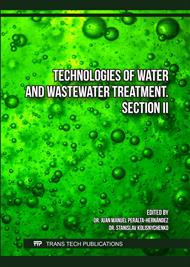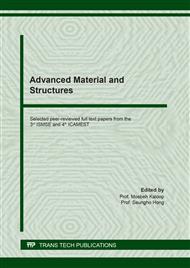[1]
Y.P. Teoh, M.A. Khan, T.S.Y. Choong, Kinetic and isotherm studies for lead adsorption drom aqueous phase on carbon coated monolith, Chemical Engineering Journal. 217 (2013) 248-255.
DOI: 10.1016/j.cej.2012.12.013
Google Scholar
[2]
F. Fu, Q. Wang, Removal of heavy metal ions from wastewaters: a review, J. Environ. Manage. 92 (2011) 07–18.
Google Scholar
[3]
A. Kausar, M. Iqbal, A.Javed, K.Aftab, Z.H. Nazli, H.N. Bhatti, S.Nouren, Dyes adsorption using clay and modified clay A review, Journal of Molecular Liquids 256 (2018) 395-407.
DOI: 10.1016/j.molliq.2018.02.034
Google Scholar
[4]
B. Crittenden, S. Perera, T. Mays, O. Camus, S. Tennison, Monolithic Adsorbents in Sustainable Development, World Congress of Chemical Engineering 7th (2005).
Google Scholar
[5]
F. Akhtar, L. Andersson, S. Ogunwumi, N. Hedin, L. Bergström, Structuring adsorbents and catalysts by processing of porous powders, J. of the European Ceramic Society. 34 (2014) 1643–1666.
DOI: 10.1016/j.jeurceramsoc.2014.01.008
Google Scholar
[6]
A. Benhouria, M.A. Islam, H. Zaghouane-Boudiaf, M. Boutahala, B.H. Hameed, Calcium alginate-bentonite-activated carbon composite beads as highly effective adsorbent for methylene blue, Chem. Eng. J. 270 (2015) 621–630.
DOI: 10.1016/j.cej.2015.02.030
Google Scholar
[7]
Y. Bentahar, C. Hurel, K. Draoui, S. Khairoun, N. Marmier, Adsorptive properties of Moroccan clays for the removal of arsenic(V) from aqueous solution, Appl. Clay Sci. 119 (2016) 385–392.
DOI: 10.1016/j.clay.2015.11.008
Google Scholar
[8]
M. Ahrouch, J.M. Gatica, K. Draoui, D. Bellido, H. Vidal, Lead removal from aqueous solution by means of integral natural clays honeycomb monolith, J. Hazard. Mater. 365 (2019) 519–530.
DOI: 10.1016/j.jhazmat.2018.11.037
Google Scholar
[9]
E. Wibowo, M. Rokhmat, Sutisna, R. Murniati, Khairurrijal, M. Abdullah, Identification of natural zeolite from Sukabumi, West Java, Indonesia: structure, chemical composition, morphology and molecular vibration, Materials Research Express, 4(6) (2017).
DOI: 10.1088/2053-1591/aa731d
Google Scholar
[10]
K. Silas, W. A. W. A. K. Ghani, T. S. Y. Choong, U. Rashid, Activated Carbon Monolith CO3O4 Based Catalyst: Synthesis, Characterization and Adsorption Studies, Environ. Tech. and Innovation. 12 (2018) 273-285.
Google Scholar
[11]
A.E. Pirbazari, E. Saberikhah, M. Badrouh, M.S. Emami, Alkali treated Foumanat tea waste as an efficient adsorbent for methylene blue adsorption from aqueous solution, Water Resources and Industry. 6 (2014) 64–80.
DOI: 10.1016/j.wri.2014.07.003
Google Scholar
[12]
N. Delgado, A. Capparelli, A. Navarro, D. Marino, Pharmaceutical emerging pollutants removal from water using powdered activated carbon: Study of kinetics and adsorption equilibrium, J. Environ. Manage. 236 (2019) 301–308.
DOI: 10.1016/j.jenvman.2019.01.116
Google Scholar
[13]
B.K. Martini, T.G. Daniel, M.Z. Corazza, A.E. Carvalho, Methyl orange and tartrazine yellow adsorption on activated carbon prepared from boiler residue: Kinetics, isotherms, thermodynamics studies and material characterization, J. of Environ. Chem. Eng. 6 (2018) 6669–6679.
DOI: 10.1016/j.jece.2018.10.013
Google Scholar
[14]
P. B. Vilela, C. A. Matias, A. Dalalibera, V. A. Becegato, A. T. Paulino, Polyacrylic acid-based and chitosan-based hydrogels for adsorption of cadmium: Equilibrium isotherm, kinetic and thermodynamic studies, J. of Environ. Chem. Eng. 7 (2019) 103327.
DOI: 10.1016/j.jece.2019.103327
Google Scholar
[15]
Y. Kong, L. Wang, Y. Ge, H. Su, Z. Li, Lignin xanthate resin–bentonite clay composite as a highly effective and low-cost adsorbent for the removal of doxycycline hydrochloride antibiotic and mercury ions in water, J. of Hazard. Mater. 368 (2019) 33–41.
DOI: 10.1016/j.jhazmat.2019.01.026
Google Scholar
[16]
R. R. Karri, J. N. Sahu, N.S. Jayakumar, Optimal isotherm parameters for phenol adsorption from aqeous solutions onto coconut shell based activated carbon: Error analysis of linear and non-linear methods, J. of the Taiwan Institute of Chem. Eng. 80 (2017) 427–487.
DOI: 10.1016/j.jtice.2017.08.004
Google Scholar
[17]
M. R. Malekbala, M. A. Khan, S. Hosseini, L. C. Abdullah, T. S. Y. Choong, Adsorption/desorption of cationic dye on surfactant modified mesoporous carbon coated monolith: Equilibrium, kinetic and thermodynamic studies, J. of Industrial and Eng. Chemistry 21 (2015) 309–377.
DOI: 10.1016/j.jiec.2014.02.047
Google Scholar
[18]
Darmadi, T.Y. Choong, T.G. Chuah, Y. Robiah, Y.H.T. Yap, Adsorption of Methylene Blue from Aqueous Soluyions on Carbon Coated Monolith, AJChE. 8 (2009) 27–38.
Google Scholar
[19]
S. Mallakpour, S. Rashimoghadam, Poly(vinyl alcohol)/Vitamin C-multi walled carbon nanotubes composites and their applications for removal of methylene blue: Advanced comparison between linear and nonlinear forms of adsorption isotherms and kinetics models, Polymer 160 (2019) 115–125.
DOI: 10.1016/j.polymer.2018.11.035
Google Scholar
[20]
X. Guo, X. J. Wang, A general kinetic model for adsorption: Theoretical analysis and modeling, J. of Molecular Liquids. 228 (2019) 111100.
DOI: 10.1016/j.molliq.2019.111100
Google Scholar
[21]
Y. S. Ho, Review of second-order models for adsorption systems, J. of Hazardous Materials B136 (2006) 681–689.
Google Scholar



